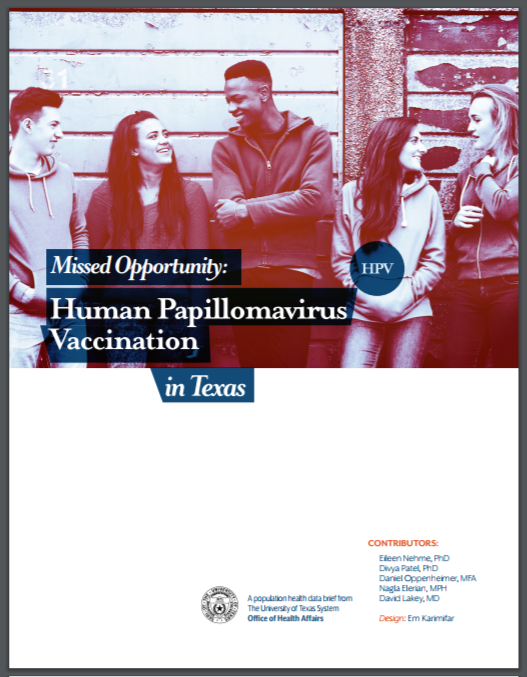Utilizing recently released data from the Centers for Disease Control and Prevention, we found that in 2016, less than a third of Texas adolescents were up-to-date on human papillomavirus (HPV) vaccinations. Only Wyoming, Mississippi, South Carolina and Utah had HPV vaccination coverage levels lower than Texas.
The vaccines offer protection from the HPV strains most closely linked to cancer. If given in two doses at ages 11 and 12 (or three doses when older), the vaccines can help prevent HPV-associated cancers in males and females. The vaccines are most effective when given at younger ages and prior to exposure to HPV.
HPV is associated with 99 percent of cervical cancers, 95 percent of anal cancers, 70 percent of throat and neck cancers, 65 percent of vaginal cancers, 50 percent of vulvar cancers, and 35 percent of penile cancers. HPV-associated cancers make up approximately 3 percent of all cancer cases among women and 2 percent of all cancer cases among men in the United States.
The data comes from the National Immunization Survey (NIS) of teens ages 13-17. The same survey data found that rates for the tetanus, diphtheria, and acellular pertussis vaccine (Tdap), and for the meningococcal conjugate vaccine (MenACWY), were 85 percent and 85.5 percent, respectively. These coverage estimates were similar to those in the U.S. overall.
Although adolescent HPV vaccination coverage in Texas has been increasing over the past decade, it has not kept pace with the U.S. overall. As recently as 2013, rates for the vaccine were on par with the U.S. average. By last year, the percentage of Texas adolescents who had received at least one dose of the HPV vaccine was 10.6 percentage points lower for females and 11.7 percentage points lower for males than the national average.
Texas ranks 47th in terms of up-to-date HPV vaccination out of the 50 states and the District of Columbia, though there is dramatic variation within the state. The 2016 estimate for up-to-date vaccination for El Paso County was 66 percent, which was higher than every state in the nation except Rhode Island. Only 23.9 percent of teens in Dallas County, on the other hand, had up-to-date coverage in 2016, which was worse than every other state and the District of Columbia.
In both the U.S. and Texas, males were less likely than females to be up-to-date on HPV vaccines. Nationally, teens living in an urban area were the most likely to be up-to-date in HPV vaccinations, while those living in more rural areas were the least likely. This variation is evident in the Texas numbers, although the difference is not statistically significant.
Additional Materials
Suggested citation: Nehme E, Patel D, Oppenheimer D, Karimifar M, Elerian N, Lakey D. (2017) Missed Opportunity: Human Papillomavirus in Texas. Austin, TX: University of Texas Health Science Center at Tyler/University of Texas System.

